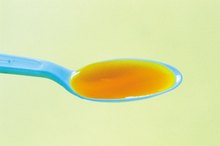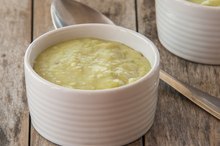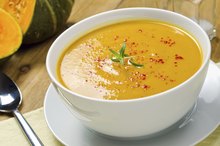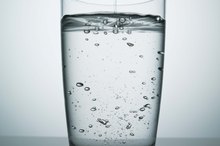Honey-Thickened Liquid Diet
A honey-thickened liquid diet is most appropriate for individuals that experience, to some degree, difficulty swallowing. Disordered swallowing function or dysphagia patients require altered consistency liquids to avoid aspiration when drinking. Dependent upon the degree of dysphagia, there are several different levels of consistency, ranging from unthickened to pudding thick. Honey-thickened liquids are those that stick to the sides of a cup like honey and pour very slowly.
Types
According to “ASHA Reader,” viscosity is a property of solids, liquids and gasses that represents their resistance to flow. While nearly all dietary fluids are considered "thin," or have low viscosity, they pose the greatest risk for aspiration into the airway. SpectrumHealth.org says honey-thickened liquids are defined as liquids that coat the spoon 1. They are pourable, but not runny. Almost all liquids can be thickened to this consistency 1. You can purchase commercial or home-thickening agents to achieve the desired honey-thick consistency. Home-thickening ingredients include:
- items such as baby cereal
- banana flakes
- cornstarch
- instant potato flakes
- plain unflavored gelatin powder
- pureed fruits such as baby foods
- According to “ASHA Reader,” viscosity is a property of solids, liquids and gasses that represents their resistance to flow.
- You can purchase commercial or home-thickening agents to achieve the desired honey-thick consistency.
Purpose
The Nectar Liquid Diet
Learn More
As explained by the National Institute on Deafness and Other Communication Disorders, individuals suffering from dysphagia have difficulty swallowing. There are varying levels of dysphagia; while some individuals may be completely unable to swallow, others can swallow specific consistencies better than others. Dysphagia is the result of any condition that weakens or damages the muscles and nerves used for swallowing. Regardless, eating and drinking becomes a challenge, making it difficult to consume enough calories and fluids to nourish the body.
- As explained by the National Institute on Deafness and Other Communication Disorders, individuals suffering from dysphagia have difficulty swallowing.
- Regardless, eating and drinking becomes a challenge, making it difficult to consume enough calories and fluids to nourish the body.
Dietary Liquids
Dysphagia patients often require a modification in not only liquid but also food consistency 1. The University of Virginia Health System states that individuals that experience difficulty swallowing liquids do not always get enough daily fluids. Therefore, it recommends drinking between six and eight cups of fluids every day. Even though a liquid may be thickened, it is still considered a part of total fluid intake. Another recommendation for patients is to consume both foods and beverages slowly while in an upright position. Continued drinking for 15 to 30 minutes after a meal will ensure all food particles have been swallowed. A straw should not be used as it may cause choking or further inhibit the swallowing process.
- Dysphagia patients often require a modification in not only liquid but also food consistency 1.
- Continued drinking for 15 to 30 minutes after a meal will ensure all food particles have been swallowed.
Diet
Pureed Food Diet
Learn More
Jackson Siegelbaum Gastroenterology reports that thickened liquid diets are nutritionally adequate; however, some patients have difficulty consuming enough food and fluid to obtain their energy and nutrient needs. The process of eating simply becomes difficult and tiring. In many cases, an adjustment to the diet or treatment will be required. Calorie and protein intake may be increased through fortification of foods. For example, milk can be fortified by adding 1 cup dry powdered milk to 1 qt. liquid milk, which can be used in cooking and baking. Strained baby fruit can be added to cooked cereal, juices or milkshakes. Or, a jar of strained baby meat can be added to soups, vegetables, sauces and gravies to increase caloric consumption.
- Jackson Siegelbaum Gastroenterology reports that thickened liquid diets are nutritionally adequate; however, some patients have difficulty consuming enough food and fluid to obtain their energy and nutrient needs.
- Or, a jar of strained baby meat can be added to soups, vegetables, sauces and gravies to increase caloric consumption.
Considerations
Individuals that require thickening of liquids in order to ensure a safe, aspiration-free swallow should always consult a language-speech pathologist first. This health care professional will perform a swallow evaluation to determine the most appropriate consistency for the patient and then recommend both products and safe foods for consumption. One key recommendation, according to the University of Virginia Healthy System, for individuals requiring a honey thickened-liquid is to avoid any consistency that will be liquid at room temperature such as:
- ice cream
- ice cubes
- gelatin
- milkshakes
Related Articles
References
- "ASHA Leader"; Dysphagia Management: Using Thickened Liquids; Russell Mills; October 2008
- Solomon NP, Dietsch AM, Dietrich-Burns KE, Styrmisdottir EL, Armao CS. Dysphagia management and research in an acute-care military treatment facility: The role of applied informatics. Military Medicine. 2016;181(5S):138-144. doi:10.7205/milmed-d-15-00170.
Writer Bio
Erica Wickham covers health, exercise and lifestyle topics for various websites. She completed an internship in dietetics and earned a Master of Science in dietetics from D’Youville College in Buffalo, N.Y. Wickham now serves as a registered dietitian.








